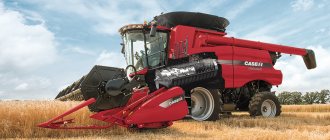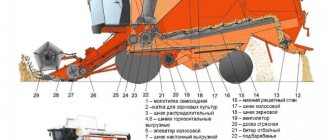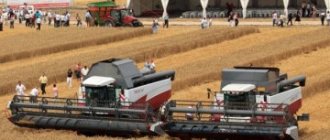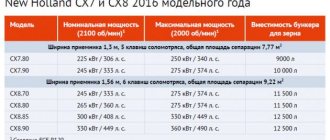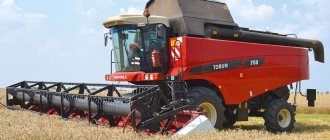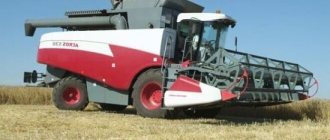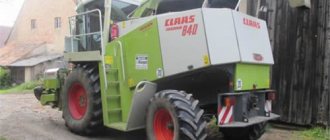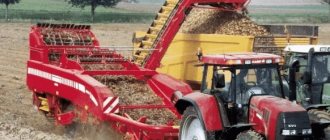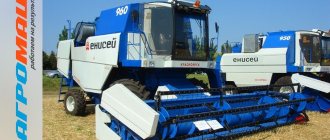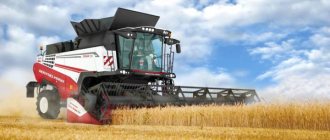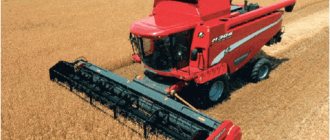About history
Lidagroprommash is a Soviet and Belarusian enterprise with a long history of more than half a century. The date of its formation is July 8, 1958. The plant was founded on the basis of a machine-building station; it received the name of the Lida Automotive Repair Center and was engaged in repairs (including major repairs) of GAZ and ZIL trucks; any types of their engines, components and assemblies.
The repurposing of the enterprise for the production of agricultural machinery occurred after the collapse of the Soviet Union, in 1992. At first, this plant for the production of agricultural machinery was called the Republican Unitary Enterprise, and since January 2004 it received its current name - OJSC Lidagroprommash. In a relatively short period of time, the plant was able to go through a difficult path from the production of simple hillers and cultivators to modern, high-tech sowing and harvesting equipment. And at the same time, to become one of the largest suppliers of agricultural machinery within the CIS and neighboring countries.
Currently, JSC Lidagroprommash produces about thirty types and standard sizes of agricultural machines, more than a dozen of which were introduced and put on the assembly line in the last 3-4 years, and, by the way, have no analogues in the post-Soviet space.
The main types of agricultural machinery produced by Lidagroprommash, in addition to combines (grain and potato harvesters), are as follows: tillage sowing units and seeders; mowers and rake-rakes; sprayers; tractor trailers. The company regularly takes part in various industrial exhibitions, both in the CIS and in European countries; works to improve the quality of its dealer and service network, mainly in the main agro-industrial regions.
Over the course of several years of operation, the peasants were able to verify the decent quality of the equipment of the Lida plant. Including the Lida-1300 combine harvesters, which not only look impressive in a modern way, but are also absolutely reliable and efficient in real economic conditions.
Features and scope of application of the Lida-1300 combine harvester
The Lida-1300 grain harvester is strikingly different from similar Soviet-era equipment, which it replaced in many peasant farms and agricultural firms. This is truly modern agricultural technology, at a qualitatively new level. The peasants immediately appreciated such features of the combine as:
- decent operating comfort for the operator in the cab with the highest level of protection from dust, noise and vibration;
- a completely new quality of threshing, with a low level of losses and the production of high-quality straw;
- grain output with an extremely high degree of purification (many experienced machine operators said that they had never seen such pure grain in their entire lives);
- the ability to unload the storage hopper located at the rear of the cabin less frequently due to its impressive volume (6,300 liters);
- reduction of losses, including through the use of a modern header design, which provides the ability to copy most ground unevenness;
- adjustment of operating speed through hydrostatics of the chassis;
- excellent visibility from the high-mounted cabin with all-round panoramic glazing.
The Lida-1300 combine harvester cuts and threshes grain, oilseeds and legumes, followed by separation and cleaning of the grain; and its placement in a bunker for unloading into vehicles. High quality cleaning without significant grain loss is achieved thanks to a three-drum threshing and separating device with a large diameter threshing drum. As additional equipment, Lida-1300 combines can be equipped with half-tracks, as well as special devices for adaptation to various agricultural crops (rapeseed attachment; separate headers and attachments for sunflower, corn, soybeans, rice, etc.)
Advantages and disadvantages, reviews
The Lida 1300 combine harvester is a new development that is not similar to its predecessors. Previous problems were taken into account and eliminated from the new design. This work provided a number of significant advantages:
- Comfort and ergonomics of the cabin, which ensures comfortable work for the driver.
- Introduction of a new system for harvesting and processing of harvested crops. This made it possible to minimize grain losses and increase the quality of straw processing.
- Improving the quality of crop processing, especially grain crops.
- Increasing the volume of the storage bin. This makes it possible to reduce the frequency of its unloading. As a result, the use of vehicles for removing processed crops is reduced.
- Reduced yield losses as a result of the use of a new threshing system and the use of a surface roughness control system.
- Availability of equipment that allows you to regulate the speed of field processing and the amount of harvested crops.
- The ability to quickly change attachments when changing the type of crop being harvested.
Combine harvester Lida 1300
Reviews of the Lida 1300 combine harvester talk about how easy it is to work with. Machine operators characterize it as high reliability, efficiency and practicality. The presence of electronics is kept to a minimum, and the thresher is started by a lever from the operator's cabin. The hydraulics installed on the combine received positive reviews. The paintwork is durable, which prevents metal corrosion. Among the disadvantages is the possibility of failure of the drum due to a foreign object getting into it. As a disadvantage, one can note the low degree of movement on wet ground.
Be sure to read: Harvester Akros 585
Technical characteristics of the Lida-1300 combine
The design of the Lida-1300 combine harvester consists of the following main components: a base, with all the power and running elements located on it: a diesel engine with drive to the propulsion elements; wheel-type chassis; electrical system; control and management systems. And also: a reaping part, with a six-blade reel, which allows you to harvest even dead grain; a threshing device equipped with a stone catcher and performing both the threshing itself and the separation of the threshed mass from grass residues. The straw walker consists of fans, grates and two elevators for different purposes - for removing plant matter, and for pouring grain into the bunker. The grain storage bin is equipped with a conveyor for loading.
Of particular interest are the results of tests of the Lida-1300 combines, carried out in 2002 at the Central Chernozem MIS: Productivity: In direct combining, at an operating speed of 4.8 km/h, the productivity per hour of main time was 11.7 t/h (2 ,8ha/h). Productivity per hour of shift time is 8.07 t/h (1.93 ha/h), and operating productivity, respectively, is 7.84 t/h (1.88 ha/h). Specific fuel consumption during shift work was 2.0 kg /t, or 6.5 kg/ha
Quality of work Total losses in direct combining of winter wheat with a yield of 42.5 c/ha, ratio of grain mass to straw mass of 1:1.3, weight of 1000 grains of 41.9 g, grain and straw moisture content of 13.9 and 9, respectively %, average ear height 98 cm, lodging 6.4% - amounted to 0.78...1.21%, which corresponds to TU and GOST 26684-85 (where the requirements are fixed: no more than 2%). The losses behind the thresher were 0.53….1.10%, which also satisfies the GOST requirement (no more than 1.5%), and the losses behind the header were 0.08…..0.11%, which satisfies the ND (no more than 0.5%)
Overall dimensions and weight of the Lida-1300 combine harvester
- Length – without header: 8.15 m, with header: 17.1 m.
- Width – without header, in transport position: 3.7 m, with header – 6.63 m.
- Height – 3.95 m.
- Ground clearance – 40.5 cm.
- Gross weight – 11.26 tons. Weight without header – 10.83 tons.
- Transport trolley weight: 750 kg.
Engine
The Lida-1300 combines use a diesel engine from the international engineering corporation Cummins, which was replaced a few years after the start of production with a domestic analogue, already produced in Minsk. The factory designation (index) of this Cummins/MMZ engine is “CASE Cummins 6TA-830”. This diesel engine is a six-cylinder power unit with a capacity of 250 horsepower, or 184 kilowatts.
This engine does not have a turbine, but its dynamic performance allows it to have sufficient power reserves under any harvesting conditions. The fuel tank capacity is 520 liters.
Header of the Lida-1300 combine
The design of the header is modern, which uses the proven patented German Schumacher cutting system. Which, by the way, is also used on new combines – “Vectors”, “Acros” and “Torums”.
Planetary drive, with a speed of 1210 cuts per minute, plus 2-groove belt drive. It operates without vibration and is very durable; Provides optimal power and a very clean cut even at high speed. Knives with an alternating top-bottom arrangement are also important for the cleanliness of the cut. In general, this design is characterized, in addition to a better cut, by much less noise and less wear.
The reel is six-bladed, of improved design, hydraulically driven, with steel teeth. The rotation speed is adjusted automatically, directly from the operator’s cab. For crops that shed easily, it is possible to achieve extremely low reel speeds, which is almost ideal for rapeseed.
The working width of the header is six meters. The speed of movement of the mowing knives is 1.71 m/s. Reel hydraulic drive rotation speed – 14..45 rpm. High-performance headers of Lida combines are equipped with a system of transverse and longitudinal copying of the soil topography, and are almost optimally adapted to specific harvesting conditions.
The reliable two-way mechanical system for repeating the contours of the earth “Avtokontur” is similar to that used on the Rostov-based “Power Stream” headers. Special electrical sensors track the position along the X/Y/Z axes simultaneously, allowing continuous control of the cutting height. If there are deviations from the required parameter, the system automatically compensates for them.
Screw diameter 610mm; screw depth 130 mm. The header attachment provides for connecting all hydraulic hoses at one point; centralized mounting of the header to the feeder chamber; There is only one drive shaft located on the left side.
Threshing and separating system and grain bin
The Lida-1300 combines use a 3-drum threshing and separating system. The drums are wide, 1300 and 1630 mm. The concave coverage angles are large, ranging from 115 – 126 – 95 degrees. The area of the threshing box is 0.81 and 1.02 m². The reels are arranged linearly; rotation speeds are proportional; the throughput is very high. The front location of the threshing drum ensures early separation of grains, direct flow of harvesting mass, and better quality of harvested straw.
In the last stage of separation, five straw walkers with four cascades operate. Their total area is 4.6 square meters. The first stage is located under the second concave. The total separation area is 6.50 sq.m. The amount of shortened straw on the sieve is significantly reduced.
A 3-stage cascade-type cleaning system operates on a sieve area of 4.21 m². A distribution slope auger has been installed. The first stage of cleaning is carried out immediately, directly behind the shaking board. The pressure is adjusted automatically, with changes in the amount of cleaned mass on the sieves. A special, patented axial fan is installed, driven by a hydraulic motor.
The load on the middle sieve has been significantly reduced. Ensured earlier cleaning and entry of grain into the bunker. Losses during harvesting on slopes have been significantly reduced. The result is excellent grain samples. And the operator has less worries with a self-regulating fan! The grain storage bin, with a volume of 6,300 liters, is completely unloaded into the back of the truck within one hundred seconds. The unloading auger rotates 107 degrees using a hydraulic cylinder. The total grain productivity is at least 12-13 t/h. The grain mass throughput is at least 8-9 kg/s.
Three-layer cleaning, included as standard equipment, ensures the threshing harvest material is especially clean. Five straw walker keys (4 cascades each) and guide baffles ensure optimal loosening of straw and minimization of losses.
Review of popular models
offers consumers several models of grain harvesters - "Lida" 1300, 1500, 1600, each with its own conveniences and capabilities.
Lida 1300
The model with index 1300 is the first of the series. Harvesting crop seeds with its help is carried out both directly and separately. The range of crops is very diverse - spikelets and corn, cereals and beans, sorghum and grasses.
Lida-1300 is characterized by:
- Copying the soil with the header both longitudinally and transversely;
- 5-key straw walker;
- 3-level seed purification;
- 3-drum threshing apparatus with separator;
- Wide threshing drum with a diameter of 600 mm.
Specifications:
| Characteristics | Unit measurements | Indicators |
| Engine type | — | GASE 6CTA-830 |
| Power | kW | 74,1-142,9 |
| Performance at 1% loss | t/h | 16,0 |
| Harvesting losses of grains with lodging less than 20% | % | 0,78 |
| Crushed content in the final product | % | 0,09 |
| Content of impurities in the final product | % | 0,15 |
| Hopper volume | l | 6300 |
Video review of the Lida-1300 combine harvester
Lida 1500
A modification of the Lida-1500 combine is the predecessor of a more powerful subsequent model labeled 1600. It presents the following differences:
- 5-key straw walker;
- 4-drum threshing apparatus with separator;
- Volumetric bunker.
Technical characteristics of the Lida-1500 grain harvester:
| Characteristics | Unit measurements | Indicators |
| Transport dimensions: | ||
| - length | mm | 17500 |
| - width | mm | 3500 |
| - height | mm | 4000 |
| Power | hp | 280 |
| Header weight | kg | 1900 |
| Threshing drum rotation speed | rpm | 370-1050 |
| Straw walker frame area | m2 | 6,9 |
| Bunker unloading time | min | 1,6 |
| Hopper volume | l | 8000 |
Lida 1600
This combine is a high-power universal special equipment for harvesting large and small-seeded crops, which has the following advantageous features:
- Equipped with headers with three working width options – 6/6.6/7.8 m;
- 6-key straw walker;
- Capacious bunker with the possibility of rare transportation;
- Centralized lubrication system for units and parts.
The Lida-1600 grain harvester has a 4-drum threshing apparatus with a wide channel measuring 1630 mm.
Specifications:
| Characteristics | Unit measurements | Indicators |
| Transport dimensions: | ||
| - length | mm | 17900 |
| - width | mm | 3600 |
| - height | mm | 4000 |
| Power | hp | 330 |
| Header weight | kg | 1900 |
| Threshing drum rotation speed | rpm | 386-1250 |
| Straw walker frame area | m2 | 7,4 |
| Bunker unloading time | min | 1,6 |
| Hopper volume | l | 9000 |
Photo of the Lida-1600 combine harvester
Cabin of the Lida-1300 combine
The Lida-1300 has a modern cabin with panoramic glazing; with extensive comfortable equipment and conveniently located controls. It provides the machine operator with very comfortable working conditions during the important and difficult time of the harvest season. The combines are equipped with a hydrostatic chassis drive, as well as an on-board computer that identifies and controls all important functions and provides up-to-date information about the machine.
The cabin of the Lida-1300 combine, originally German and then entirely Belarusian, is reliably protected from dust, vibration, and excess noise. The machine control panel is maximally optimized. And automatic temperature regulation provides excellent comfort during long work in the field.
Owner reviews about Lida-1300 combines
Reviews about the practical use of Lida-1300 combines are quite mixed, although most of them are still positive. All owners and machine operators note the extreme purity of the resulting grain and a negligible percentage of losses. Almost everyone is satisfied, and many are very pleased with the performance of the reliable 250-horsepower Cummins/MMZ diesel engine. Both its efficiency and productivity are excellent: 500 liters of diesel fuel is enough for two harvesting days; and a day the combine easily harvests about forty hectares.
The design is quite simple, with a minimum of electronics; the thresher is simply turned on with a lever. Extremely maneuverable combine harvester. Bosch hydraulics work flawlessly. The straw chopper is always set to “min”, because at “max” it simply turns it into dust and fine dust. The metal is of high quality, does not rust, the paint does not peel off the body or parts. No one has any complaints here. And in terms of fuel consumption, the Lida-1300 combine is incomparably “nicer” than the outdated “Dons” and “Nivas” - it consumes 2-2.5 times less diesel fuel!
However, many peasants, having taken the Lida-1300, were significantly “burned” by this purchase. Yes, the combine harvests well, and the grain comes out very clean, but the build quality leaves much to be desired, and the combine may require repairs already in the first year of its service. As a rule, these claims for careless assembly most often relate to Lida-1300 combines, assembled not at Lidaagroprommash, but in the city of Izhevsk.
Device
The Lida 1300 grain harvester consists of components and assemblies that ensure its movement and harvesting.
Transport units include:
- High power engine and support systems.
- Transmission.
- Power supply system.
- Chassis.
- Management and control bodies.
The combine harvesting system includes:
- Motovilovo.
- Grain hopper with unloading auger.
- Separating device.
- Threshing system.
- System of supply and discharge augers.
- Sieve set: top, cascade and spike.
- Elevator for harvest.
- Delimiter.
- Catcher for stones and foreign objects.
The machine operator controls the units and components from his cab.
Cabin
The first combine harvesters were equipped with German-made cabins. In the process of modifications and improvements, the cabins were replaced with domestic analogues. The modern combine cabin has side windows on all sides, which allows the operator to conduct a panoramic inspection of the area. This makes it possible to observe the work of the header and at the same time dispense the harvested crop through the side auger. Rear view mirrors increase visibility. The operator's cabin is a separate module. In case of breakdown, it can be completely dismantled. The seat and steering wheel are adjustable. Additional ergonomics are achieved through a convenient instrument panel and side manipulator. The cabin is protected from vibration, dust and noise. Equipped with an air conditioning system.
Additional equipment
Recently, units have been produced with a built-in on-board computer. He is able to completely control the harvesting. The on-board computer can simultaneously perform several important tasks:
- Monitoring of combine components and assemblies during operation.
- Recording data regarding quantity and type of crop harvested.
- Determination of the area of harvested fields.
- Controlling the start and end times of cleaning work.
- Drawing up a detailed map of the degree of productivity of each field.
The Lida 1300 combine can use half-tracks. It is used as additional equipment. Special devices are used for harvesting various agricultural crops. This could be an attachment for harvesting rapeseed, or special headers for clearing a field of corn, sunflower, buckwheat and other crops. A separate addition is the double-sided mechanical system, which allows the cutting unit to follow the contour of the ground. Built-in sensors monitor surface unevenness in all planes. As a result of using such a system, the cutting height of the crop is maintained and the cutting knives are prevented from sticking into the ground.
Operating Parameters
The long period of operation of the unit indicates that the technical characteristics of the Lida 1300 combine can solve any harvesting tasks.
Engine and fuel consumption
From the beginning of production until recently, Cummins diesel engines were installed on Lida combines. The installation of engines of this corporation is carried out on a significant amount of equipment that performs agricultural harvesting, road and construction work. Recently, the production and installation of a domestic analogue of Cummins/MMZ – CAST Cummins 6TA-830 – has been launched. Domestic production has made the price of the engine much cheaper, but both engines have the same parameters. They have 6 cylinders and have a power of 250 hp. (185 kW). The engine is highly efficient and economical. A full tank of diesel fuel is enough for two days of work. Taking into account the standards, the combine must harvest 40 hectares of crop per day. Accordingly, 500 liters of fuel is enough to harvest 80 hectares of crops at a harvesting speed of 5-6 km/h.
Conclusion on Lida-1300 combines
Everything can be learned by comparison, and if you compare the Lida-1300 combine harvester with obsolete agricultural machines Don or Niva (and even Niva-Effect), then it can offer a much higher harvesting speed and better grain cleaning quality , at much lower fuel costs.
However, the Lida-1300, of course, is not an advanced model of agricultural machinery close to the world's top agricultural machinery. This is just a copy of the outdated model of the Case-525 combine, produced in Europe in the 90s of the twentieth century. Compared to combines such as Polesie-1218 or Akros-530, Lida-1300 is smaller in size and noticeably weaker in productivity. Therefore, agricultural producers in Russia and the former fraternal republics still, for the most part, prefer Polesie, Akros and Vectors to Lida.
Prices of Lida-1300 combines on the modern market
The cost of the new Lida-1300 combine harvester in the basic and only configuration, with a header, is 4,100,000 rubles from dealers of the Belarusian enterprise. Used combines of this brand, produced in the 2000s, are offered on the secondary market at prices ranging from 1,200,000 to 2,200,000 rubles; 2010s - from 2 million rubles, depending on their technical condition. At the same time, there is a strong opinion about combines of earlier years of production, made more than 80 percent from German-made components, as being of higher quality and more durable.
Analogues and cost
The Lida 1300 combine has newer and more modern analogues. These include the same type of combines Lida 1500 and Lida 1600. They are distinguished by a larger bunker volume, a larger straw walker and a high-performance separator. A characteristic difference is the increased grip of the header. As a result, the harvesting area becomes larger and the harvesting time of the fields is reduced. The cost of the new Lida 1300 combine is in the range from 4.5 to 5.5 million rubles. The price depends on the manufacturer and configuration of the unit. Belarusian-assembled combines will cost more than combines produced in Russia. A used combine harvester is evaluated according to several parameters. The year of manufacture, the technical condition in general and individual components and assemblies are taken into account. Mileage, availability of spare parts and additional equipment are taken into account. Based on this, the cost of a combine can range from 0.5 to 1.7 million rubles.
Lida 1300 is no longer a new product on the agricultural harvesting equipment market. But given its characteristics, positive qualities and low cost compared to more modern machines, it remains popular for harvesting.

